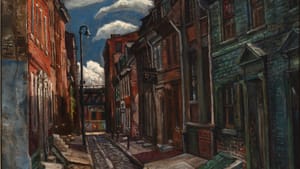Stay in the Loop
BSR publishes on a weekly schedule, with an email newsletter every Wednesday and Thursday morning. There’s no paywall, and subscribing is always free.
Looking at the Lopers
The Delaware Art Museum presents ‘The Loper Tradition’

To inaugurate its Distinguished Artist series, Delaware Art Museum has a unique retrospective of father-and-son painters Edward Loper senior and junior. The series celebrates artists whose regional impact has been felt for 50 years or more. Artists, students, and institutions have been engaged with a Loper—father or son—for decades.
Exhibitions often seek out new interpretations or explore art-history patterns. Curator Margaret Winslow’s goal in this retrospective—like the museum’s recent look at Victorian artist Barbara Bodichon—was to “disrupt historical amnesia” and present something inadequately documented or not at the forefront of the community.
Looking deeper
Early in his career, Edward Loper Sr. (1916-2011) worked in the Federal Art Project (1935-43), the New Deal program of the Works Progress Administration (WPA). There, he documented items for the Index of American Design and also produced his own paintings. From that period, on view here is After a Shower (1937), the first African American painting acquired by the museum. It’s a moody landscape that bears little resemblance to what would become the senior Loper’s signature technique of building representational works not with line but with blocks of color.
The older Loper charged himself and his dedicated cadre of students to “look deeper,” thanks in part to observational relationship studies with Violette de Mazia at the Barnes Foundation. His practice was to begin in one place on the canvas and build additively, putting colors one beside the other to create lush, dense forms. Like John Sloan and the “Ashcan” artists whose art he would have known, the painter often elevated the urban scenes others might ignore, as in Pigeon Coops (1952). As well as depicting Wilmington or Philadelphia scenes, he liked to work in Canada, feeling a warmer welcome there as an African American. And he often worked outdoors en plein air, as in Quebec City, La Porte Street (1978).
The next generation
Edward Loper Jr. (born 1934) was also an educator, teaching at Wilmington’s Howard High School and Christina Cultural Arts Center. However, his paintings often flew under the art-world radar, according to Winslow, and fewer people understood the scope of his work. He also studied at the Barnes, and though influenced by his father—as both teacher and critic—the younger Loper was an expert draftsman (even in grade school). His paintings often show a love of line, and he was also interested in sculpture, structure, and three-dimensional mass, predilections visible in works like Reading Terminal (late 1900s), Brooklyn Bridge 100th Birthday (1983), and Kalmar Nyckel (1996), depicting the reconstructed vessel that brought the Swedes to Delaware.

Father and son together
Though a few works are displayed throughout the museum to put these artists in context, most of the exhibition’s 30 paintings are in an intimate and warmly lit second floor gallery. By hanging them intermingled in close proximity, Winslow encourages direct visual comparison.
The most interesting side-by-side look greets the viewer at the exhibition’s entrance. Twenty-five years apart, each man painted Elfreth’s Alley. The father’s 1948 depiction skews the street from right to left, buildings looming over a tunnel-like cobblestone corridor only partially lit by the cloud-filled sky. Painted from the same vantage point but totally contrasting in viewpoint, the son’s 1973 depiction of the cobbled alley (oriented from left to right) is glowing brilliantly, faceted and fairly dancing with reflected and refracted light. Expanding this variance across the exhibition, any similarities seem to be undergirded by vastly different life views.
Over the years, each man was seen in multiple regional solo and group exhibitions, including Wilmington and Philadelphia. But they’ve been hung together only once, in a small 1970s showcase at the museum’s former downtown gallery. This is the first comprehensive and comparative showcase of this father and son who have painted, taught, and mentored generations.
Running concurrently in a separate gallery (through May 12) are two 30-minute documentaries, one about each artist. Related exhibition programs include conversational events with artists, students, and community members taught or influenced by the Lopers, whose artwork and generational impact—beginning with the elder Loper in the early 20th century and continuing with his son to the present—span almost a century.
What, When, Where
The Loper Tradition: Paintings by Edward Loper Sr. and Edward Loper Jr. Through August 4, 2019, at the Delaware Art Museum, 2301 Kentmere Parkway, Wilmington, Delaware. (302) 571-9590 or delart.org.
The Delaware Art Museum is a wheelchair-accessible venue and welcomes visitors with disabilities. For specific information about accessibility, call the museum or visit online.
Sign up for our newsletter
All of the week's new articles, all in one place. Sign up for the free weekly BSR newsletters, and don't miss a conversation.

 Gail Obenreder
Gail Obenreder